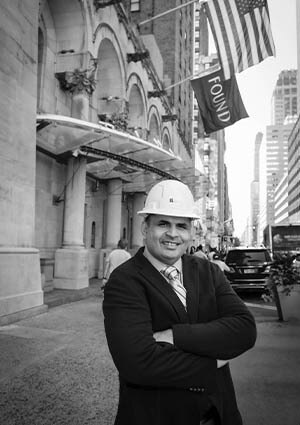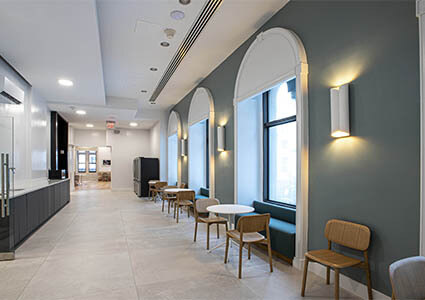Tackling lead time has never been this easy, as Danielle Champ hears from building conversion expert, Tallal Bhutta
Lead time has quickly become one of the biggest challenges facing the construction industry. Fortunately, one specialist in the sector is working twice as hard to get ahead of the curve for his clients. Specializing in conversion and the renovation of existing buildings, Tallal Bhutta is an expert in getting the job done quickly.
He features as this edition’s main interview for cracking the code and finding a way to minimize project lead time. With over 20 years of field experience, and three engineering degrees – one in civils from New York University, and two master’s degrees in structural engineering and construction management from Stevens Institute of Technology – Tallal is a product of experience and education. Now, he is the Founder and CEO of BDB Construction Enterprise. “We try to work as partners instead of typical vendors. We try to be proactive, creative, and innovative every step of the way, which is what makes us different,” Tallal begins.

In our conversation, he stipulates that over 70 percent of projects are behind schedule, and it is this very statistic that he is on a mission to improve. “Construction is full of uncertainties that come from unforeseen conditions. You must be able to predict them somehow, and that prediction should happen during the design phase. From my perspective, as a construction professional, if the project is not finished on time, it has failed. I’m passionate about breaking that cycle. It requires creativity and training, which also makes the work very rewarding.”
Early contractor involvement
According to Tallal, lead times grow because contractors are not involved in the design phase. They get involved later in the project, which, in his opinion, is too late. “If you’re going to finish something on time, contractors must be involved sooner. But nobody pays attention to this problem. There’s a project methodology called early contractor involvement, where we encourage involvement of contractors as early as possible. This is important because throughout projects, costs go up and schedules fall apart. But for some reason, this issue is not highlighted as it should be. This is what we do for our clients. And we have produced very good results recently in New York City.”
As a practical example, Tallal highlights how the business was able to speed up lead-times impressively through the conversion of two hotels into student housing. “The first challenge is that they require different zoning permissions. However, through our methods, from closing of the building sale to occupancy, the projects took seven months each. Typically, seven months is how long the early design phase takes. That’s why we’re different.”
So, in real terms, how are Tallal and his team able to turn projects of this scale around so quickly? The answer is simple. The company tackles projects through a piecemeal process. “Let’s say when it comes to filing the drawings, we will file only the part that is enough to get us started, like the demolition phase, instead of doing the whole design set, which takes months. Then, we share with the architect or the owner what we think are the challenges, and then our proposals to overcome them. This is our approach not only to the design, but the entire process. This method is also helpful as the owner learns to trust us through our proactive involvement, which also empowers our decision-making.”
The bigger picture
Considering the implications the pandemic has had on the construction industry, an approach like this seems a logical response to ensuring a swift project turnaround, so how come it isn’t widely practiced? Tallal explains that there’s a lack of coordination between different trades. “If there’s a design change, you call the architect, the architect comes forward, they look at it, and then they suggest what needs to be done. This is time consuming. A small issue could take weeks or months to resolve, but in a project where you have seven months to finish building, these issues have to be dealt with quicker than that. I believe that as a contractor, you have to already look at the potential challenges and have a solution ready.
 “It’s also important to keep in mind that the buildings we work on have a lot of infrastructure work involved; the plumbing, electrical, mechanical, and fire safety systems of the building have to be changed. So, if a contractor brings in his own engineer, it could make it easier for the work to take place, because then they have a successful working relationship. So that’s also important,” he shares, adding that, typically, architects might suggest their own tradespeople to work on the project, which introduces a possible dissonance in working relationships. “If I have my own mechanical and electrical engineer to resolve an issue, I simply message them over text or email. However, if I work with someone I’m not familiar with, they might ask for meetings first to have a look at the issue, then head back to the office to suggest a solution. In other instances, some people like delaying operations because it runs the bill as they get paid on an hourly basis. These are all factors that need to be taken into consideration.”
“It’s also important to keep in mind that the buildings we work on have a lot of infrastructure work involved; the plumbing, electrical, mechanical, and fire safety systems of the building have to be changed. So, if a contractor brings in his own engineer, it could make it easier for the work to take place, because then they have a successful working relationship. So that’s also important,” he shares, adding that, typically, architects might suggest their own tradespeople to work on the project, which introduces a possible dissonance in working relationships. “If I have my own mechanical and electrical engineer to resolve an issue, I simply message them over text or email. However, if I work with someone I’m not familiar with, they might ask for meetings first to have a look at the issue, then head back to the office to suggest a solution. In other instances, some people like delaying operations because it runs the bill as they get paid on an hourly basis. These are all factors that need to be taken into consideration.”
Throughout our conversation, we gain a deeper look into Tallal’s outlook on his work ethic. So, taking a more personal turn in the conversation, when asked about where his leadership style and philosophy to construction came from, Tallal expresses that it runs in the family. “My uncle, who happens to be my mentor as well, used to say that you should always look at the bigger picture. Whenever I’m in the middle of a project, that’s what I focus on. Surprises happen, changes arise unexpectedly. But if I stopped the project, or if I delayed the work, at the end of the day, the client will not be happy, and even if I make some money from the job, if it costs me the client’s relationship, it’s not worth it. In my opinion, I think you should aim for the bigger picture, and not worry about smaller issues.”
Project excellence
Although Tallal’s uncle does not come from an engineering background, he did start his career as a waterproofing contractor, and has maintained an exemplary work ethic, which continues to influence his nephew today. “He suggested that I should look at a career in engineering as there’s a lot of opportunity in the sector. When it came to the challenges he faced, he would give me advice based on his experience. That’s how he came to be so important in the development of my own career, I paid close attention to his own work ethic.”
With the guidance of his uncle’s mentorship, and the proven evidence of his own ingenuity, Tallal’s contribution to the sector could have a lasting impact. Moving forward, he is keen to continue his path, and see the business grow in its capabilities. “I want to keep doing what I love and keep improving in the renovation business. This will include doing more high-profile projects. We’re going to keep using both traditional and modern tools, and strive for excellence in all aspects of our projects,” he concludes.